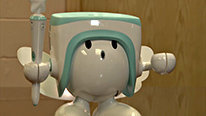NSF Awards: 1640135
Public media producers from WGBH and Kentucky Educational Television, and researchers from the Education Development Center (EDC) have teamed up on the project Integrating Computational Thinking into Mathematics Instruction in Rural and Urban Preschools.
The team is exploring young children’s computational thinking (CT) learning and preschool teachers’ CT understanding as they engage with playful prototype hands-on activities and digital tablet apps that integrate CT into preschool math instruction.
The team first developed a CT learning blueprint and a CT/math alignment document, and from those foundational resources created a set of tablet app and hands-on activity prototypes that focus on the CT concepts of sequencing, debugging, and modularity and align with the preschool math Building Blocks curriculum. The prototypes were developed in stages, with iterations tested in classrooms and discussed with teachers during monthly visits to rural and urban preschools. After each monthly visit, researchers analyzed classroom observation notes and identified promising practices and areas for improvement for each of the prototypes tested. In total, the team has produced three CT apps and 12 CT hands-on activities that align with preschool math instruction. We are currently analyzing results of our classroom video observations and exploratory learning task analysis to understand children’s CT learning and teachers’ CT understanding.
This video provides an overview of the project and showcases the teaching and learning process of educators and children as they experience apps and activities in both rural and urban preschool classrooms.










Susan Jo Russell
Principal scientist
The glimpses of preschool students engaged in mathematics in this video are fascinating and tantalizing. I'm a long-time math educator and professional developer, but I admit that this whole CT world is pretty new to me and I'm trying to make sense of what the CT activities add to a carefully designed, rigorous, well thought-out math curriculum such as Building Blocks. For example, I notice in the video that students are working on activities that have to do with pattern and regularity similar to what might already be in a good math curriculum. Can you explain, perhaps with an example or two, how a CT activity would add to what students might be doing in math? How is "debugging," for example, in a repeating pattern activity, different from noticing and considering errors in a math activity? Thanks so much.
Marisa Wolsky
Executive Producer
Hi Susan, Thanks so much for your interest in our project. Here are two activities that integrate CT and math and go beyond debugging and error in a math equation. Let us know if you would like any more information. Very best, Marisa
Monkey Bridge (CT skill: Debugging; Math: Geometry [3-D shapes]): Children build a bridge out of blocks using the monkeys’ diagram (made up of a rectangular prism and four cylinders, the structure is designed to collapse). Children are then challenged to debug the structure: to figure out why it won’t stand up and then make changes—using the same shapes—to create a stable bridge. Extension: There’s a second monkeys’ bridge design using rectangular and triangular prisms that also requires debugging.
Make a Monkey Story (CT skill: Sequencing; Math: Counting, Ordinality): Children make a story by putting three pictures of the monkeys making lemonade in the right order, based on the math clues in the pictures. The teacher might ask them questions like this to help them think it through:
Mia Dubosarsky
Your excellent video provides a good understanding of the intervention.
As a fellow preschool researcher, I wonder what are the main behaviors/outcomes you observed? Did you develop your own measures?
Also, did you find any difference between children's learning through the apps and hands-on activities? Thanks.
Heather Lavigne
Research Scientist
Hi Mia, thanks for your questions! During this 2-year exploratory research project, we gathered data while educators tested the CT hands-on activities and digital app prototypes. Our objective was to evaluate how well our pedagogical approach worked for integrating CT into preschool math. To achieve this, we developed a classroom observation toolkit that field researchers used to collect this data. Educators and children were observed using a set of indicators used to evaluate how successful the prototypes were in engaging children in CT practice and in leveraging children’s math knowledge. Observers also captured key behaviors and verbalizations from teachers and children. Teachers were interviewed following the observations to explore what they thought the successes and challenges were from their classroom experiences.
Because we were in the exploratory phase of this work, we focused on understanding the meaning-making teachers and children do during these CT activities and identifying ways to further support these classroom experiences. Future project work will move toward evaluating children’s learning as a result of these activities.
Denise Schultz
Instructional Math Coach
Hi! I think your video could be used to recruit preschool teachers! It all looked like so much fun and your clips capture such great moments as students learn through play and exploration. Thank you for sharing. I have a lot of questions for you but mostly because I too am new to this CT world. Does your alignment document align the CT goals to the curricular content or to instructional practices? And how much overlap is there between the CT skills and the math, science, and engineering practices? Can the language and concepts of "debugging" be generalized and applied to any problem solving situation regardless of content and did your project explore this? I see the obvious connection to problem solving in mathematics but I'm wondering about problem solving in science or even in social situations.
Heather Lavigne
Research Scientist
Thanks Denise! These are great questions, as the world of CT is very new for early childhood education. While our project was focused on preschool math, there are other researchers who are aligning CT to other STEM areas like science and engineering. The alignment document we mentioned in the video was focused on exploring connections between the CT skills that are in our blueprint and the skills that are taught during preschool math instruction. We used the Building Blocks preschool math curriculum to perform our alignment. We highlighted how CT skills like developing knowledge about sequencing and algorithms relates to preschool math skills like understanding numbers and operations or patterns and algebraic thinking. The alignment document described sample activities from Building Blocks that are used to address these math skills and the instructional strategies teachers might use to scaffold the learning experience.
We’ve spent a lot of time talking about how CT is different from problem solving. What seems to be different about CT is that it builds students toward the proficient use of systematic processes and strategies for solving complex problems. In many cases, we observed children using trial and error as their basis for solving problems before receiving further instruction. Computational thinking aims to give children a toolkit that can be used to break a complex problem down to its core parts and use CT strategies to generate solutions.
Denise Schultz
Beth Sappe
Director - STEM Mathematics
Hello,
Thanks for sharing your video. I am happy to see the integration of computational thinking put into math classes through a strategic process. How were the teachers who are part of the study trained in computational thinking prior to implementing the lessons? Do you have plans to evaluate how students that engaged in these activies perform in math in later years compared to students that were not given the opportunity?
Thanks, Beth
Marisa Wolsky
Executive Producer
Hi Beth,
Because we were in the exploratory phase of this work, we didn't focus on evaluating children’s current learning nor their future learning as a result of these activities, rather we focused on understanding the meaning-making teachers and children do during these CT activities and identifying ways to further support classroom experiences.
The training for teachers consisted of a one-day workshop. One advantage of our study design was that the same teachers participated throughout the iterative testing of the activities they were able both to inform their design as well as get repeated exposure to the same activities.
Thanks for your interest in our project, Marisa
Mahtob Aqazade
Thank you for sharing your video! It is so amazing how young children attend to debugging practices. I am wondering were they experiencing the three CT concepts, sequencing, debugging, and modularity in different environments. I am also very new to the world of computational thinking, in our research project, we worked with older children (1st and 3rd) playing a tangible coding game. As part of transferring from computer science to mathematics, we were looking for math tasks that could help to leverage debugging strategies in math. I am curious to learn more about other resources. Thank you!
Marisa Wolsky
Executive Producer
Hi Mahtob,
Our study didn't have children experiencing the concepts in different environments. The activities we developed were always implemented in a preschool classroom. However, they were designed for a variety of settings within the classroom (small group, circle time, etc.). Our activities (hands-on, non-digital and tablet apps) were designed to have children apply computational thinking in non-programming contexts, every day, preschool-relatable problems (like packing a picnic or having a dance party) and then incorporated the use of math (counting, use of ordinals, geometric shapes) in solving those problems. Our resources are still in development but we'd be happy to share when we have completed that process. Best, Marisa
Sandy Wilborn
Thanks for sharing! Computational thinking is vital for success in mathematics.
Our teachers in rural Virginia have many of the same challenges that I am sure you all face. Oftentimes, there is only one teacher in the entire district who teaches a course, so it is not possible to plan or discuss strategies with others. In our US Dept of Ed i3 project, teachers in rural Virginia collaborate in a virtual network to create lesson plans, video instruction, and provide feedback to others. Please take a look at our video "If You Give a Teacher a Network" to learn about how Pre-Algebra and Algebra I teachers in rural Virginia are able to work with like-minded teachers.
Marisa Wolsky
Executive Producer
Hi Sandy,
Thanks for your interest. Our team will absolutely take a look at your video. I'm sure we have a lot to learn from each other's project.
Best, Marisa
Further posting is closed as the showcase has ended.